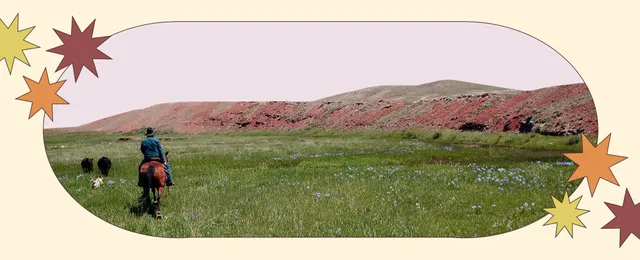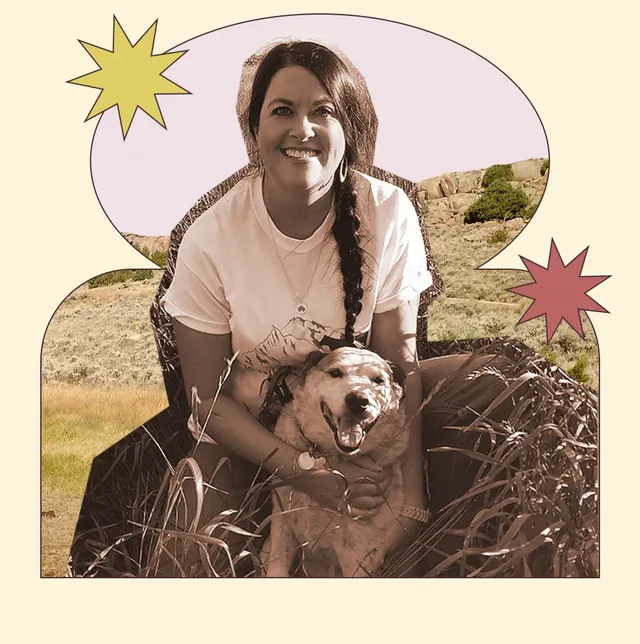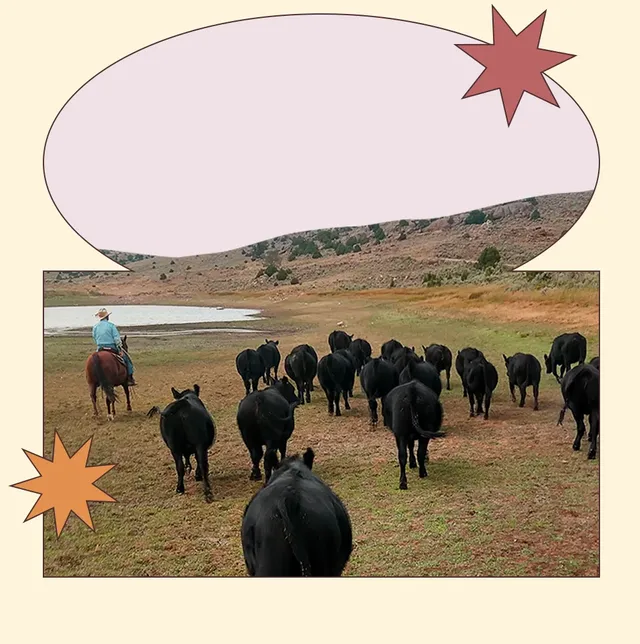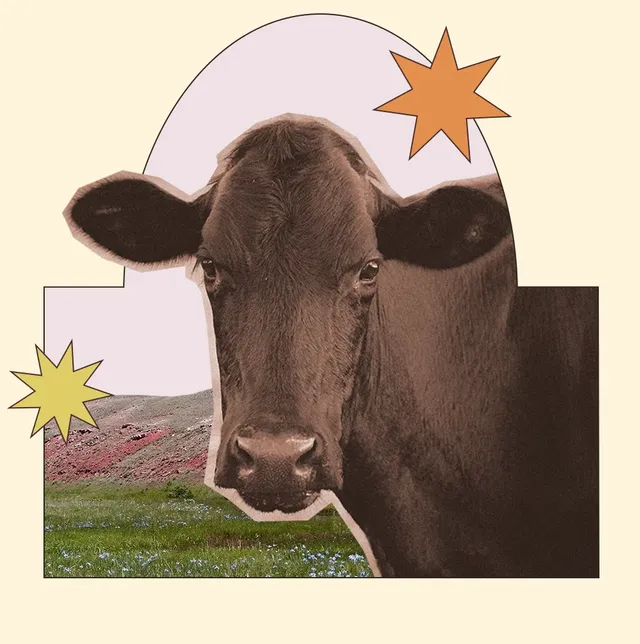This Modern Cowgirl Is Keeping Sustainability in Mind on Her Fifth-Generation Ranch

This Modern Cowgirl Is Keeping Sustainability in Mind on Her Fifth-Generation Ranch
Kacy Atkinson's great-grandfather came to Wyoming in the 1880s, and her family has been working the land ever since. At her ranch, Atkinson Land and Livestock, about 85 miles outside of Laramie, WY, she raises cattle for beef with her mother and father — it's an around-the-clock job dedicated to the land and the animals they care for, and she wouldn't have it any other way.
Now Atkinson advocates for the cattle industry under the brand 10 Miles Past Nowhere and shares her day-to-day life on social media. We spoke to Atkinson about being a cowgirl in a men-dominated industry, what it's like to be a fifth-generation rancher, and how she's contributing to the sustainability conversation.

PS: How did you get into cattle ranching?
KA: I was born into it. My dad gave me my very first cow when I was about 3 months old, and I've had cows ever since. I didn't intend to stay here — I went to college in Texas and worked in higher education for a while. But about six years ago, my brother unexpectedly passed away, and I decided it was time for me to come home and continue what my family built. We've invested so much time and love and sweat and tears into this, and I wanted to come back and be a part of that.
PS: Cattle ranching seems like a men-dominated industry. Is that changing?
KA: Historically, it's been a very male-dominated industry, but we are seeing a shift. Women bring a lot to the table. It's become very apparent that women are just as capable as men and that we have a lot to offer and can do the work. Maybe we won't do it in the same way, but that's OK. Sometimes it doesn't matter how you get to point C as long as you get there. That's starting to be recognized by the industry as a whole: as men are retiring as the leaders of cattlemen associations, they are being replaced in large numbers by women, and that's really important for the future.

PS: Can you walk us through a typical day on the ranch?
KA: Cattle ranching is a seven-day-a-week, 365-day-a-year job. There's always more work to be done than can get done. When you live on a ranch, you have this idea of what you want to do for the day, but sometimes your day gets dictated based on the disasters you find along the way, like if the cows break the fence down and go to the neighbors' — I'm going to have to get my horse and get them back where they belong and are safe — on the right side of the fence. And then I'm going to have to fix that fence behind them so they stay there.
We're good at figuring out what's critical and what you can worry about tomorrow. The cows need to be fed, so that always comes first. If we're in the middle of calving season, we'll make sure that none of them are having problems having a baby. Whether the fence is fixed or you get the barn clean, maybe some of those projects can be punted down the road.
PS: What is it like living in the middle of nowhere?
KA: Our ranch is about 85 miles outside of Laramie, WY. That's where I had to go to high school, and that's where we have to go to the grocery store to get milk. It's very isolated. It's 40-plus miles to the highway in any one direction. We only get our mail twice a week.
When you're being raised here, you don't realize it's different. But you don't get weekends off. You don't go to dinner with your friends. You don't go to the movies. But then again, I don't get stuck in traffic unless my cows are blocking the road. I have lots of wide-open spaces, and I can go for a hike or go fishing anytime I want. I can sit on my deck and enjoy a cocktail and take in the sunset every day and have that be unobstructed. So I think it's all a trade-off. There are great things and great challenges to both situations.
PS: According to the UN State of Food and Agriculture report, the US has had the lowest intensity of beef greenhouse-gas emissions in the world since 1996. How are you keeping sustainability and the environment in mind while ranching?
KA: "Sustainability" is one of those words that means something different to every single person. If I were to ask my dad, "Is the cattle industry sustainable?" He'd be like, "We've been here for four generations. Of course we're sustainable." For many in the cattle industry, sustainability is being able to keep our ranches viable for future generations. But like many Americans’ definition, it is also about properly managing the environment.
Agriculture is about trying to learn to work with Mother Nature because Mother Nature is the queen around here. She rules the kingdom. It's all about figuring out, how am I going to work with her: Because my entire existence is dependent upon my being respectful and taking care of the things that she's giving me.
We know that we have improved drastically in sustainability over the last few decades, and we're going to continue to do those things as an industry. Of course, there are big, exciting new technologies on the horizon, but I would argue, that some of the little decisions we make every single day to improve and to make sure that we can be here for the long run are what ultimately make us sustainable. Things like being intentional about our land and water use or protecting the soil. Ranchers and farmers have invested their whole lives and hearts into this. Their goal is to see it sustained for the next generation.
PS: Are there any misconceptions about beef you'd like to set straight?
KA: We get criticism about greenhouse gas emissions because cattle produce methane through their burps. But when we look at methane, it will break down and be removed from the atmosphere in about 10 to 12 years, whereas carbon dioxide from things like burning fossil fuels for cars and airplanes can take up to a thousand years to disintegrate.3 Still, the industry is researching new technologies like seaweed feed additives to reduce the amount of methane that cattle produce, and there is some really exciting research about converting methane into a natural gas that could be used to fuel cars.
How incredible would that be? We could have a positive impact on the climate. But today, we already play an important role in carbon sequestration. Cattle are part of a natural cycle that recycles the methane they emit back into the soil, which stores between 10 percent and 30 percent of the world’s carbon.1
On the ranch, sustainability also means caring for the land, and cattle have some pretty cool impacts on ecosystems. Cattle ranching preserves those natural spaces that we all want to keep intact and prevents them from being developed by construction. We are able to protect habitats for hundreds of endangered species across the country and even increase the health of the plants and soil through proper grazing.1,2 It’s all part of working hand-in-hand with Mother Nature. So instead of viewing cattle negatively, let's view them as the potential hero in this story for the fact that they already make a meaningful difference.
Credits: Design: Samantha Shin; Photography: Kacy Atkinson
- Silveira, et al. 2012. Carbon sequestration in grazing land ecosystems. University of Florida Extension. https://edis.ifas.ufl.edu/pdffiles/SS/SS57400.pdf
- Barry, Sheila. 2021. Beef Cattle Grazing More Help than Harm for Endangered Plants and Animals.
- UC Davis. 2020a. Clear Center. The Biogenic Carbon Cycle and Cattle. https://clear.ucdavis.edu/explainers/biogenic-carbon-cycle-and-cattle

